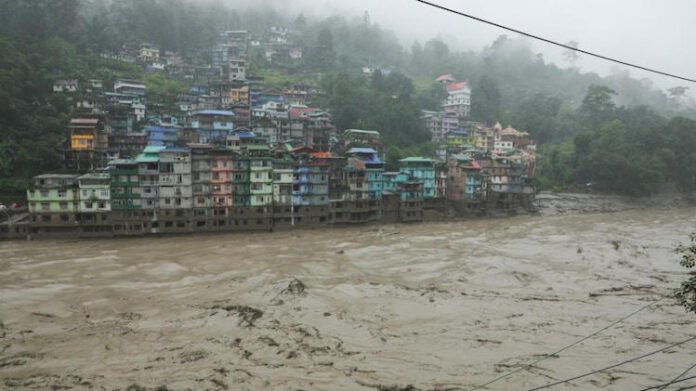Sikkim, known for its stunning landscapes and pristine environment, has been facing the brunt of heavy rainfall in recent days. The Teesta River, a lifeline for the region, has swelled significantly, raising concerns among authorities and local residents alike. As the monsoon lashes parts of the state with relentless downpours, the situation calls for urgent attention and proactive measures to mitigate the risk of flooding and other hazards.
The Teesta River, originating from the glaciers of the Himalayas, is a vital source of water for Sikkim and the neighboring states of West Bengal and Assam. It plays a crucial role in supporting agriculture, hydroelectric power generation, and the overall ecosystem of the region. However, during the monsoon season, the river often swells to dangerous levels, posing a threat to communities living along its banks.
The recent heavy rainfall has exacerbated the situation, causing the Teesta River to overflow and inundate low-lying areas. Several villages and agricultural fields have been submerged, forcing residents to evacuate to safer locations. The rising water levels have also led to concerns about potential landslides and infrastructure damage in vulnerable areas.
Authorities in Sikkim have been closely monitoring the situation and have issued warnings to residents living in flood-prone areas. Emergency response teams have been deployed to assist with evacuation efforts and provide relief to affected communities. Local administrations are working in coordination with state and central agencies to assess the extent of the damage and take necessary steps to ensure the safety and well-being of residents.
The threat of flooding in Sikkim is not new, as the state is prone to heavy rainfall and associated hazards during the monsoon season. However, the intensity and frequency of extreme weather events, including heavy rainfall and flash floods, have increased in recent years due to climate change. Rising temperatures and changing weather patterns have made extreme weather events more unpredictable and severe, posing significant challenges for disaster management and preparedness efforts.
In response to the growing threat of climate-related disasters, authorities in Sikkim have been working to strengthen resilience and adaptive capacity at the local level. This includes initiatives to improve early warning systems, enhance infrastructure resilience, and promote community-based disaster risk reduction measures. However, the recent rainfall and flooding serve as a stark reminder of the urgent need for greater investment in climate resilience and disaster preparedness across the region.
The impact of flooding extends beyond immediate damage to infrastructure and property. It can also have long-term consequences for agriculture, livelihoods, and the environment. Floodwaters carry sediment and pollutants downstream, affecting water quality and aquatic ecosystems. In addition, the displacement of communities and loss of agricultural land can have lasting social and economic impacts on affected populations.
In light of these challenges, there is a growing recognition of the need for a holistic approach to flood management that integrates disaster risk reduction, climate adaptation, and sustainable development principles. This includes measures to conserve natural ecosystems, such as wetlands and forests, which play a critical role in regulating water flow and reducing the risk of flooding.
As Sikkim grapples with the aftermath of heavy rainfall and flooding, there is an opportunity to reevaluate existing strategies and policies for managing flood risk in the region. This includes strengthening early warning systems, improving infrastructure resilience, and enhancing community-based disaster preparedness efforts. By investing in proactive measures to build resilience and adapt to climate change, Sikkim can better protect its people, infrastructure, and natural resources from the impacts of future extreme weather events.

